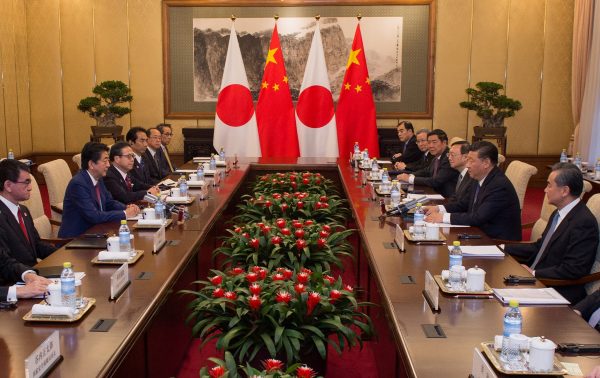Abe’s visit to China is part of ongoing efforts from both sides to ‘renormalise’ Japan–China relations through resuming high-level dialogue. This renormalisation effort consists of two aspects.
First is restoring China–Japan relations from the series of incidents that catalysed its initial deterioration. Namely, the entrance of a Chinese vessel into Japanese territorial waters around the Senkaku/Diaoyu Islands in 2008, the 2010 collision between a Chinese fishing vessel and a Japan Coast Guard vessel and the Japanese government’s transfer of the Senkaku/Diaoyu Islands from private to public ownership in 2012.
Japan hopes to relaunch a cooperative development program in the East China Sea that was first agreed upon in 2008 between then leaders Hu Jintao and Yasuo Fukuda. It is also attempting to reach agreements on maritime communication and joint search and rescue mechanisms in the East China Sea that restore order to the contested waters.
Japan has had some success in eliciting a consensus from China on these points. Chinese vessels have made frequent appearances in territorial waters and contiguous zones around the Senkaku/Diaoyu Islands since 2012. China is keen to persist with these endeavours and maintain the status quo in the East China Sea.
The second aspect of the renormalisation effort is realigning Japan–China relations to reflect China’s economic strength and position as a global power. Japan stopped extending loans to China back in 2008, but now it has also officially announced that it will cease official development assistance payments. China expressed its gratitude to Japan for its support on both fronts, and the two countries exchanged — as equals — a memorandum on over 50 projects for business cooperation in third countries.
From China’s perspective, Japan appears to have now wholesale accepted its Belt and Road Initiative (BRI). During his meeting with Chinese Premier Li Keqiang in May 2018, Abe explained that ‘the possibility of cooperation will be explored on a case-by-case basis, under the proviso that openness, transparency, economic efficiency and financial soundness all accord to international standards’. In other words, Japanese cooperation is only guaranteed provided strict conditions are met.
These conditions are by no means being publicised in China. But it is safe to assume that the more than 50 projects that Abe greenlighted in Beijing all met, or will meet, these conditions. The current Japanese posture seems to point to the possibility that the BRI could coexist with Japan’s own ‘Free and Open Indo-Pacific Strategy’.
Shifts in US–China relations significantly impacted Abe’s visit. While covertly criticising the United States for its anti-globalisation turn, Xi Jinping and Li Keqiang expressed their hope that Japan and China could combine forces to take the United States head on. But the likelihood of such a joint Japan–China push back against the United States is slim. Still, Xi maintained a critical stance vis-a-vis the United States’ proclivity for unilateralism during the summit talks and both sides highlighted the importance of a diversified trade regime.
There is also a possibility that China now sees Abe as a conduit for rekindling links with the Trump administration. Abe has been making heavy use of the media to promote aspects of the talks that would tick US boxes, including China–Japan dialogue on intellectual property rights and a moratorium on technological cooperation.
Seizing the opportunity of the 40th anniversary of the signing of the Japan–China Treaty of Peace and Friendship, Abe’s visit to China has helped to inject new momentum into the renormalisation of bilateral relations. Observers are now pinning their hopes on a reciprocal visit to Japan by Xi in 2019.
Despite this progress, the backdrop of growing China–US tension hangs over the renormalisation effort and both parties were careful to keep Washington in mind during the proceedings. Should tensions continue and the United States altogether abandons its engagement policy towards China, Japan will likely continue to engage. What this would mean for US–Japan relations is a looming uncertainty.
The majority of the notes exchanged at the summit talks were merely symbolic gestures with little substance. The memorandums on third country cooperation were signed under tight conditions stipulated by the Japanese, and only time will tell if future agreements on cooperation in the East China Sea eventuate.
Ultimately, the biggest concerns in China–Japan relations — issues pertaining to sovereignty, territory, historical perceptions and Taiwan — remain unresolved. It appears that any further developments will have to wait until Xi’s 2019 Japan visit.
Shin Kawashima is Professor in the Graduate School of Arts and Sciences, University of Tokyo.
This article was translated by Thomas Barrett.

